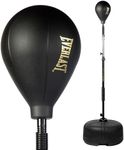Buying Guide for the Best Punching Bags
Choosing the right punching bag is all about matching the bag to your training goals, available space, and personal preferences. Punching bags come in various shapes, sizes, and materials, each designed to serve different types of workouts, from boxing and kickboxing to general fitness and stress relief. Before making a decision, think about how you plan to use the bag, where you will place it, and what kind of feel you want when you hit it. Understanding the key features will help you find a bag that supports your training and keeps you motivated.Type of BagThe type of punching bag refers to its shape and intended use, such as heavy bags, speed bags, double-end bags, and free-standing bags. Heavy bags are long and cylindrical, great for practicing powerful punches and kicks. Speed bags are smaller and designed to improve hand-eye coordination and speed. Double-end bags are anchored at both ends and help with accuracy and rhythm. Free-standing bags are mounted on a base and can be moved easily. To choose the right type, consider your training focus: if you want to build strength and power, a heavy bag is ideal; for speed and reflexes, a speed or double-end bag is better; and if you need portability, a free-standing bag is convenient.
WeightThe weight of a punching bag affects how much it moves when struck and how much resistance it provides. Lighter bags (around 40-70 pounds) swing more and are suitable for beginners, children, or those focusing on speed and technique. Medium-weight bags (70-100 pounds) offer a balance between movement and resistance, making them good for most adults and general training. Heavier bags (over 100 pounds) provide more resistance and less swing, which is better for powerful hitters and those practicing heavy strikes. Choose a weight that matches your strength and training style: if you want more resistance and less movement, go heavier; if you want more movement and speed, go lighter.
Material and FillingPunching bags are made from different outer materials like synthetic leather, genuine leather, or canvas, and filled with materials such as fabric, sand, or water. Synthetic leather is durable and affordable, while genuine leather offers a premium feel and long-lasting quality. Canvas is less expensive but may wear out faster. The filling affects the bag's firmness: fabric-filled bags are softer and easier on the hands, while sand or water-filled bags are firmer and heavier. If you want a bag that lasts and feels good to hit, look for quality outer material and a filling that matches your comfort level and training intensity.
Size and LengthThe size and length of a punching bag determine how much striking area you have and what techniques you can practice. Shorter bags (about 3 feet) are mainly for punching, while longer bags (4-6 feet) allow for both punches and kicks, making them suitable for kickboxing or MMA. The diameter also matters: wider bags offer a larger target and more resistance. Choose the size based on your training needs and available space: if you only box, a shorter bag is fine; if you want to kick as well, go for a longer bag.
Mounting and PlacementHow you mount or place your punching bag affects convenience and safety. Hanging bags require a sturdy ceiling or wall mount, which is more permanent but saves floor space. Free-standing bags sit on a weighted base and can be moved around, making them ideal for home gyms or shared spaces. Consider your available space and whether you can install hardware; if not, a free-standing bag is a flexible choice.



















